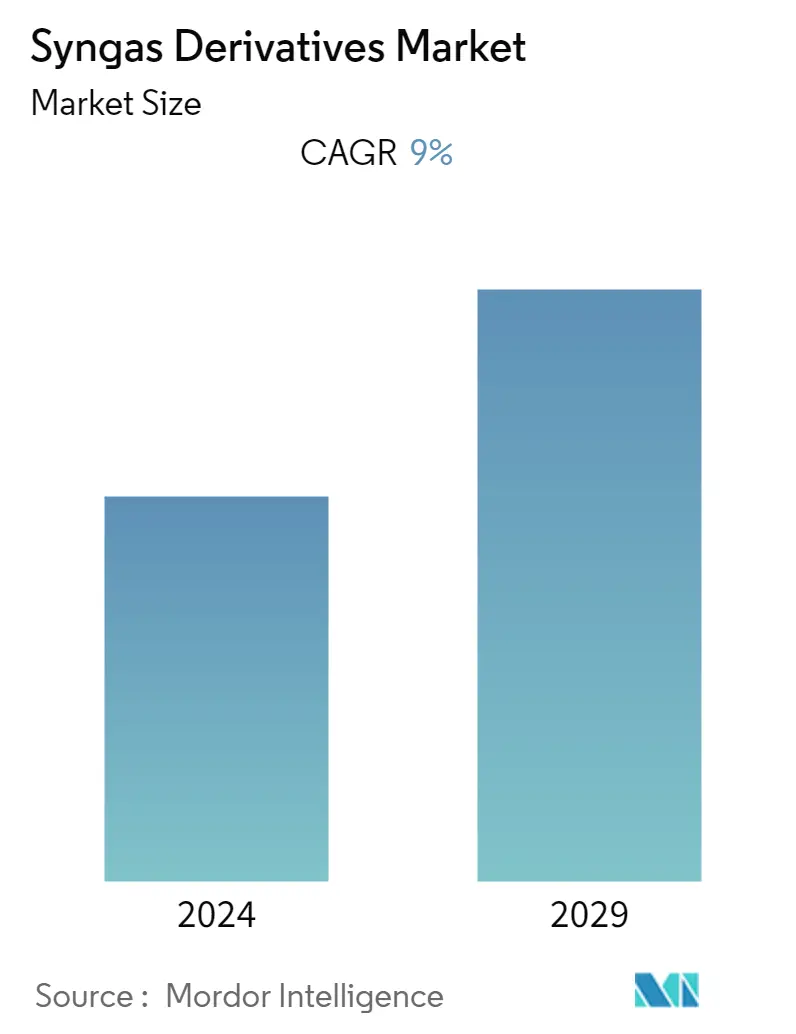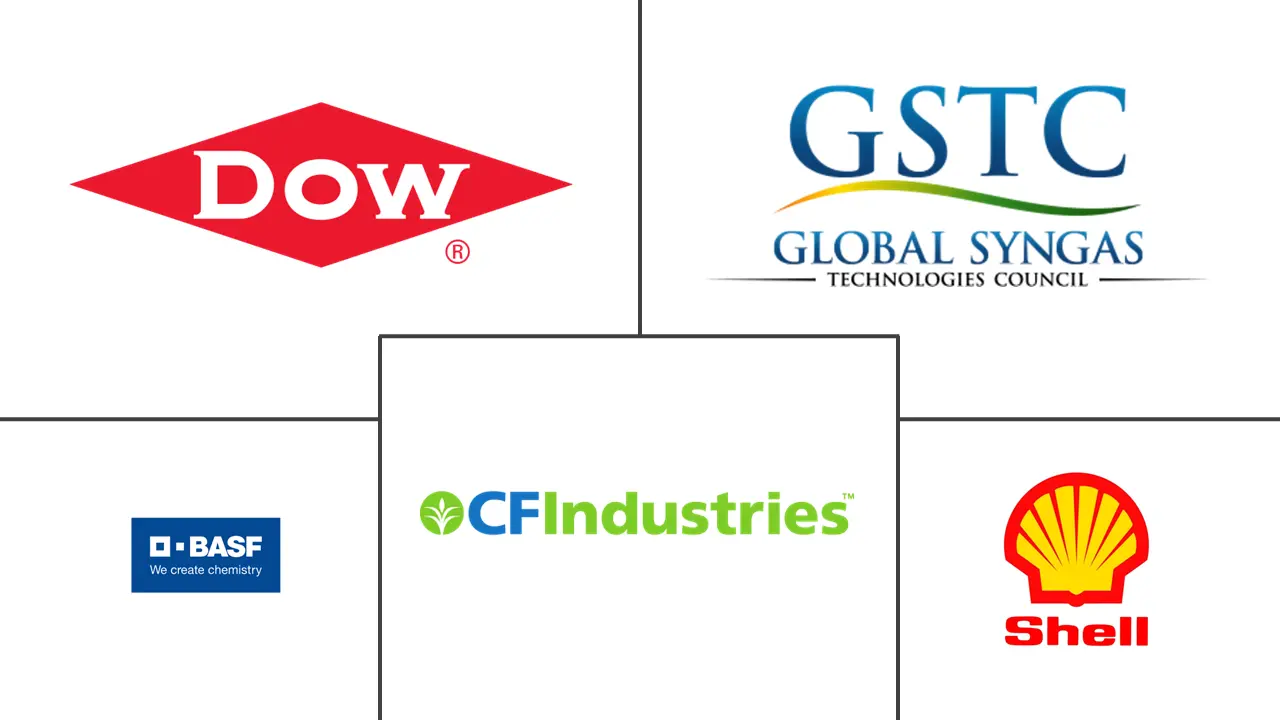Market Size of Syngas Derivatives Industry

| Study Period | 2019 - 2029 |
| Base Year For Estimation | 2023 |
| CAGR | 9.00 % |
| Fastest Growing Market | North America |
| Largest Market | Asia-Pacific |
| Market Concentration | Medium |
Major Players
*Disclaimer: Major Players sorted in no particular order |
Need a report that reflects how COVID-19 has impacted this market and its growth?
Syngas Derivatives Market Analysis
The Syngas Derivatives market is anticipated to register a CAGR of over 9% during the forecast period. The COVID-19 epidemic spared the syngas and derivatives market across the globe. The number of syngas and derivatives production units was disrupted due to interruptions in the supply chain caused by low fuel demand. Furthermore, the need for plastic expanded, particularly in the healthcare sector and personal protection equipment, raising the demand for the chemical sector's syngas and derivatives market.
- Over the short term, growing environmental constraints and the emergence of clean technologies can be attributed to the increased demand for syngas and derivatives. Because of the high pollution levels worldwide, governments in many nations are encouraging citizens to embrace clean technologies. These concepts and activities will likely contribute to the global market's bright future in terms of growth. R&D initiatives in syngas and derivatives are also expected to help the business develop. Businesses invest considerably in R&D to increase their income. Massive investments will likely boost the global market in the long run and drive market growth during the forecast period.
- However, some impediments to syngas and derivatives market growth include substantial capital costs and the time required to build an operating plant with cutting-edge gasification techniques.
- Nevertheless, rapid urbanization, infrastructure development, and discoveries in the oil & gas industry are some significant factors contributing to cushioning overall industry growth and giving substantial potential in the forecast period.
- Regarding revenue, Asia-Pacific is expected to dominate the global market during the forecast period and includes the highest market share in the worldwide syngas derivatives market.
Syngas Derivatives Industry Segmentation
Syngas, also known as synthesis gas, synthetic gas, or production gas, is a mixture of hydrogen, carbon monoxide, and, more frequently than not, carbon dioxide. It is mainly used as a fuel and in producing other compounds. Syngas is utilized extensively in the chemical, power generating, liquid fuel, and gaseous fuel industries and is made from various carbon-containing materials. Examples include biomass (wood gas), petroleum, polymers, coal, municipal garbage, and similar materials. The growing need to reduce fossil fuel dependency due to scarcity is a significant growth factor for the syngas and derivatives sector. Primary constituents, derivatives, applications, end-user industry, and geography segment the syngas derivatives market. By primary constituents, the market is segmented into methanol, dimethyl ether, ammonia, oxo chemicals, and hydrogen. By derivatives, the market is segmented into formaldehyde, methanol-to-olefins (MTO)/methanol-to-propylene (MTP), methyl tert-butyl ether (MTBE)/ tertiary amyl methyl ether (TAME), dimethyl terephthalate (DMT), acetic Acid, dimethyl ether (DME), and methyl methacrylate (MMA). By application, the market is segmented into aerosol products, LPG blending, power generation, transportation fuel, acrylates, glycol ethers, acetates, lubes, resins, and other applications. By end-user industry, the market is segmented into agriculture, textiles, mining, pharmaceutical, refrigeration, chemicals, transportation, energy, refining, welding and metal fabrication, and other end-user Industries. The report covers the market size and forecast for the syngas derivatives market in 15 countries across major regions. For each segment, the market sizing and forecasts have been done based on value (USD million) and volume (tons) for all the above details.
| Primary Constituents | |
| Methanol | |
| Dimethyl Ether | |
| Ammonia | |
| Oxo Chemicals | |
| Hydrogen |
| Derivatives | |
| Formaldehyde | |
| Methanol-to-olefins (MTO)/Methanol-to-Propylene (MTP) | |
| Methyl Tert-butyl Ether (MTBE)/ Tertiary Amyl Methyl Ether (TAME) | |
| Dimethyl Terephthalate (DMT) | |
| Acetic Acid | |
| Dimethyl Ether (DME) | |
| Methyl Methacrylate (MMA) |
| Application | |
| Aerosol Products | |
| LPG Blending | |
| Power Generation | |
| Transportation Fuel | |
| Acrylates | |
| Glycol Ethers | |
| Acetates | |
| Lubes | |
| Resins | |
| Other Applications |
| End-User Industry | |
| Agriculture | |
| Textiles | |
| Mining | |
| Pharmaceutical | |
| Refrigeration | |
| Chemicals | |
| Transportation | |
| Energy | |
| Refining | |
| Welding and Metal Fabrication | |
| Other End-User Industries |
| Geography | |||||||
| |||||||
| |||||||
| |||||||
| |||||||
|
Syngas Derivatives Market Size Summary
The Syngas Derivatives Market is poised for significant growth, driven by increasing demand for clean technologies and environmental sustainability. The market, which experienced disruptions during the COVID-19 pandemic due to supply chain issues, is now rebounding as the demand for syngas derivatives in the chemical sector, particularly for plastics in healthcare and personal protection equipment, rises. The market's expansion is further supported by substantial investments in research and development, aimed at enhancing production processes and reducing costs. Despite challenges such as high capital expenditures and the time required to establish advanced gasification plants, the market benefits from rapid urbanization, infrastructure development, and advancements in the oil and gas industry, which provide substantial growth opportunities.
Asia-Pacific is expected to maintain its dominance in the global syngas derivatives market, supported by abundant coal and natural gas reserves, urbanization, and infrastructure growth. The region's leadership is bolstered by China's significant production of ammonia and hydrogen, alongside its strategic plans for hydrogen energy development. The transportation fuel segment, particularly Power-to-Liquid (PtL) fuels, is anticipated to see robust growth, with innovations in syngas generation processes like co-electrolysis offering cost advantages. Major industry players, including BASF SE, CF Industries Holdings, Inc., Dow Inc., and Shell PLC, are actively investing in projects to enhance their market positions and contribute to the industry's decarbonization efforts.
Syngas Derivatives Market Size - Table of Contents
-
1. MARKET DYNAMICS
-
1.1 Drivers
-
1.1.1 Growing Environmental Constraints, as well as the Emergence of Clean Technologies
-
1.1.2 Initiatives in Syngas and Derivatives R&D
-
-
1.2 Restraints
-
1.2.1 Substantial Capital Costs and the Time Required to Build an Operating Plant with Cutting-Edge Gasification Techniques
-
1.2.2 Other Restraints
-
-
1.3 Industry Value-Chain Analysis
-
1.4 Industry Attractiveness - Porter's Five Forces Analysis
-
1.4.1 Bargaining Power of Suppliers
-
1.4.2 Bargaining Power of Buyers
-
1.4.3 Threat of New Entrants
-
1.4.4 Threat of Substitute Products and Services
-
1.4.5 Degree of Competition
-
-
-
2. MARKET SEGMENTATION
-
2.1 Primary Constituents
-
2.1.1 Methanol
-
2.1.2 Dimethyl Ether
-
2.1.3 Ammonia
-
2.1.4 Oxo Chemicals
-
2.1.5 Hydrogen
-
-
2.2 Derivatives
-
2.2.1 Formaldehyde
-
2.2.2 Methanol-to-olefins (MTO)/Methanol-to-Propylene (MTP)
-
2.2.3 Methyl Tert-butyl Ether (MTBE)/ Tertiary Amyl Methyl Ether (TAME)
-
2.2.4 Dimethyl Terephthalate (DMT)
-
2.2.5 Acetic Acid
-
2.2.6 Dimethyl Ether (DME)
-
2.2.7 Methyl Methacrylate (MMA)
-
-
2.3 Application
-
2.3.1 Aerosol Products
-
2.3.2 LPG Blending
-
2.3.3 Power Generation
-
2.3.4 Transportation Fuel
-
2.3.5 Acrylates
-
2.3.6 Glycol Ethers
-
2.3.7 Acetates
-
2.3.8 Lubes
-
2.3.9 Resins
-
2.3.10 Other Applications
-
-
2.4 End-User Industry
-
2.4.1 Agriculture
-
2.4.2 Textiles
-
2.4.3 Mining
-
2.4.4 Pharmaceutical
-
2.4.5 Refrigeration
-
2.4.6 Chemicals
-
2.4.7 Transportation
-
2.4.8 Energy
-
2.4.9 Refining
-
2.4.10 Welding and Metal Fabrication
-
2.4.11 Other End-User Industries
-
-
2.5 Geography
-
2.5.1 Asia-Pacific
-
2.5.1.1 China
-
2.5.1.2 India
-
2.5.1.3 Japan
-
2.5.1.4 South Korea
-
2.5.1.5 Rest of Asia-Pacific
-
-
2.5.2 North America
-
2.5.2.1 United States
-
2.5.2.2 Canada
-
2.5.2.3 Mexico
-
-
2.5.3 Europe
-
2.5.3.1 Germany
-
2.5.3.2 United Kingdom
-
2.5.3.3 France
-
2.5.3.4 Italy
-
2.5.3.5 Rest of Europe
-
-
2.5.4 South America
-
2.5.4.1 Brazil
-
2.5.4.2 Argentina
-
2.5.4.3 Rest of South America
-
-
2.5.5 Middle-East and Africa
-
2.5.5.1 South Africa
-
2.5.5.2 Saudi Arabia
-
2.5.5.3 Rest of Middle-East and Africa
-
-
-
Syngas Derivatives Market Size FAQs
What is the current Syngas Derivatives Market size?
The Syngas Derivatives Market is projected to register a CAGR of 9% during the forecast period (2024-2029)
Who are the key players in Syngas Derivatives Market?
BASF SE , CF Industries Holdings, Inc., Dow Inc., Shell PLC and SynGas Technology, LLC are the major companies operating in the Syngas Derivatives Market.

